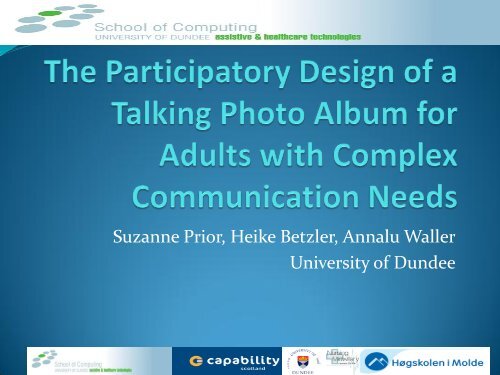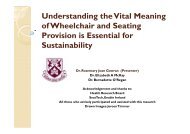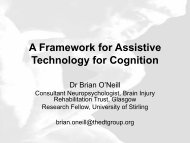Suzanne Prior, Heike Betzler, Annalu Waller University of Dundee
Suzanne Prior, Heike Betzler, Annalu Waller University of Dundee
Suzanne Prior, Heike Betzler, Annalu Waller University of Dundee
Create successful ePaper yourself
Turn your PDF publications into a flip-book with our unique Google optimized e-Paper software.
<strong>Suzanne</strong> <strong>Prior</strong>, <strong>Heike</strong> <strong>Betzler</strong>, <strong>Annalu</strong> <strong>Waller</strong><br />
<strong>University</strong> <strong>of</strong> <strong>Dundee</strong>
Introduction<br />
• MSc Project in Summer 2010<br />
• Used as part <strong>of</strong> a PhD Project<br />
• “The Creation <strong>of</strong> Guidelines for the Involvement <strong>of</strong><br />
Adults with CCN in User Centred Design”<br />
• HB has undergraduate degree inEconomics and<br />
International Business and studying for MSc in<br />
Computing.
Initial Project Brief<br />
• Previous projects have shown adults with CCN enjoy<br />
sharing stories.<br />
• HB was to develop s<strong>of</strong>tware to support them in some<br />
way with this.
Complex Communication Needs (CCN)<br />
• Legal Definition “Unable to<br />
meet communication needs”<br />
due to:<br />
• Limited or no speech AND<br />
• Physical / Intellectual /<br />
Medical needs<br />
E.g. Cerebral Palsy,<br />
Developmental Delay<br />
• Also, Acquired<br />
Communication Impairment,<br />
e.g. stroke, Parkinson’s disease<br />
• Exact numbers not known<br />
• 600,000 in UK not able to<br />
communicate yes/no<br />
Aldous J. What worked for us. The Times. 2008 February 12, 2008.
Stories<br />
• Communication is an<br />
essential part <strong>of</strong> life<br />
• An important part <strong>of</strong><br />
communication is the<br />
ability to tell stories.<br />
• These stories can include<br />
• every day events up to<br />
momentous life occasions.<br />
• Through stories people<br />
• build relationships<br />
• learn new information<br />
• can argue their point <strong>of</strong><br />
view.
Stories Are Learnt Early On<br />
• We learn to be good story tellers from early in life……….
Stories and CCN<br />
• However, people with<br />
complex communication<br />
needs (CCN) cannot access<br />
their stories easily.<br />
• voice output<br />
communication aids are<br />
not suited to sharing stories<br />
• it is difficult to<br />
• create a story,<br />
• store it,<br />
• retrieve it and<br />
• narrate it
Stories and CCN<br />
• People with CCN <strong>of</strong>ten<br />
rely upon a carer to enter<br />
stories into the device<br />
• Time consuming and<br />
results in static,<br />
monologue output<br />
• Story text tends to be<br />
stored under a single key.<br />
Today at the care centre I<br />
had lentil soup for lunch,<br />
in the morning I had<br />
speech physio and then in<br />
the afternoon I went to the<br />
art group.
Speaking Photo albums<br />
• Another way <strong>of</strong> sharing<br />
stories is through<br />
photographs<br />
• Some use being made <strong>of</strong><br />
“speaking photograph<br />
albums”;<br />
• allowing voice recordings<br />
to be linked to individual<br />
photographs.<br />
• Still relies on speaking<br />
helpers<br />
• Playback still mimics a<br />
monologue.
Talking Photograph Album<br />
• The problems were addressed within a participatory<br />
design project<br />
• The project followed participatory design guidelines<br />
being developed at the School <strong>of</strong> Computing at the<br />
<strong>University</strong> <strong>of</strong> <strong>Dundee</strong> (<strong>Prior</strong> 2010).<br />
• Six adults with CCN and a support worker were<br />
enabled to participate in all stages <strong>of</strong> the design using<br />
innovative design methods
Level <strong>of</strong> Involvement<br />
• The participants helped design the s<strong>of</strong>tware from low<br />
level paper based designs through to a fully working<br />
piece <strong>of</strong> s<strong>of</strong>tware.
Design Methods<br />
• Design methods included:<br />
• Magnetic White Boards<br />
• E-Tran Boards<br />
• PowerPoint Designs
Results <strong>of</strong> Product<br />
• It has been possible to design the s<strong>of</strong>tware so that the<br />
users can be aided in creating much <strong>of</strong> the photograph<br />
linked story independently
Results <strong>of</strong> Methods<br />
• The adults with CCN<br />
• greatly enjoyed taking part in the developing a system<br />
for themselves<br />
• were able to contribute fully as participants<br />
• Provided further evidence that adults with a wide<br />
variety <strong>of</strong> intellectual and physical impairments can<br />
take a meaningful role in participatory design<br />
• when they are given appropriate support<br />
• where careful consideration is put into the planning <strong>of</strong><br />
the design process to facilitate interaction.
My Photo Album<br />
<strong>Heike</strong> <strong>Betzler</strong>
Where was this picture taken?<br />
the garden outside the library in Perth Scotland
When was this picture taken?<br />
in 2003 when I was in my last year <strong>of</strong> school
Who was with you?<br />
my friends Jenni and Rachel
What would you like to say about the photo?<br />
when we studying after School
How was it, how did it make you feel?<br />
This was usually good fun
Where was this picture taken?<br />
Brussels
When was this picture taken?<br />
2 years ago in the summer.
Who was with you?<br />
my parents
What would you like to say about the photo?<br />
looking at the sunset
How was it, how did it make you feel?<br />
I didn't like the food.
EXIT
EXIT






